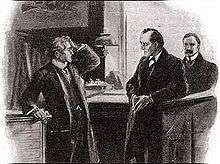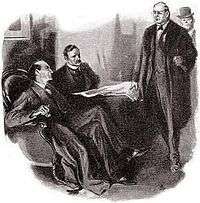The Adventure of the Bruce-Partington Plans
| "The Adventure of the Bruce-Partington Plans" | |
|---|---|
|
< Mycroft Holmes visiting his brother, 1912 illustration by Arthur Twidle | |
| Author | Arthur Conan Doyle |
| Series | His Last Bow |
| Publication date | 1908 |
"The Adventure of the Bruce-Partington Plans" is one of the 56 Sherlock Holmes short stories written by British author Sir Arthur Conan Doyle. It is one of eight stories in the cycle collected as His Last Bow, and is the second and final appearance of Mycroft Holmes. Doyle ranked "The Adventure of the Bruce-Partington Plans" fourteenth in a list of his nineteen favourite Sherlock Holmes stories.[1]
Plot summary
The monotony of thick smog-shrouded London is broken by a sudden visit from Holmes' brother Mycroft. He has come about some missing, secret submarine plans. Seven of the ten pages — three are still missing — were found with Arthur Cadogan West's body. He was a young clerk in a government office at Royal Arsenal, Woolwich, whose body was found next to the Underground tracks near the Aldgate tube station, his head crushed. He had little money with him (although there appears to have been no robbery), theatre tickets, and curiously, no Underground ticket. The three missing pages by themselves could enable one of Britain's enemies to build a Bruce-Partington submarine.

It seems clear that Cadogan West fell from a train and that he stole the plans, meaning to sell them, but the mystery is truly complex.
Inspector Lestrade tells Holmes that a passenger has seen fit to report hearing a thud at about the location in question, as though a body had fallen on the track. He could not see anything, however, owing to the thick fog.
After an examination of the track near Aldgate, Holmes reaches an astonishing and unusual conclusion: West had been killed elsewhere, was deposited on the roof of an Underground train, and fell off when the jarring action of going over the points at Aldgate shook the coach.
Holmes decides to visit Sir James Walter, who was in charge of the papers. He has, however, died, apparently of a broken heart from the loss of his honour when the papers were stolen, according to his brother Colonel Valentine.
West's fiancée is a bit more informative. There was something on his mind for the last week or so of his life. He commented to her on how easily a traitor could get hold of "the secret" and how much a foreign agent would pay for it. Then, on the night in question, as the two of them were walking to the theatre, near his office, he dashed off, never to be seen again.

Holmes next goes to the office from which the plans were stolen. Sidney Johnson, the senior clerk, tells Holmes that as always, he was the last man out of the office that night, and that he had put the papers in the safe. Anyone coming in afterwards to steal them would have needed three keys (for the building, the office, and the safe), but no duplicates were found on West's body, and only the late Sir James had all three keys. Johnson also mentions that one of the seven recovered pages might also be indispensable to a foreign agent. This will prove important later. Holmes also discovers that it is possible to see what is happening inside the office from outside even when the iron shutters are closed.
After leaving, Holmes finds that the clerk at the nearby Underground station remembers seeing West on the evening in question. He was most shaken by something, and took a train to London Bridge.
Acting on information from Mycroft, and on what he has learnt thus far, Holmes identifies a person of interest, Hugo Oberstein, a known agent who left town shortly after West's murder. Some small reconnaissance shows Holmes that Oberstein's house backs onto an above-ground Underground line, and that, owing to traffic at a nearby junction, trains often stop right under his windows. It seems clear now West's body was laid on the train roof — the evidence shows that he was not dropped from a height — just there. The only remaining questions are about who killed him and why.
Holmes and Dr. Watson break into Oberstein's empty house and examine the windows, finding that the grime has been smudged, and there is a bloodstain. An Underground train stops right under the window. It would be easy to lift a dead man onto a train roof, as was apparently done. Some messages from the Daily Telegraph agony column, all seeming to allude to a business deal, are also found, posted by "Pierrot", and this gives Holmes an idea. He posts a similarly cryptic message in the Times demanding a meeting, signing it Pierrot, in the hopes that the thief — assuming it is not West — might show up at Oberstein's house.

It works. Colonel Valentine Walter shows up and is stunned to find Holmes, Watson, Lestrade, and Mycroft all waiting for him. He confesses to the theft of the plans, but swears that it was Oberstein who killed West. He had followed the Colonel to Oberstein's and then, injudiciously, intervened, and Oberstein beat his head in. Oberstein then decided, over the Colonel's objections, that he had to keep three of the papers, because they could not be copied in a short time. He then got the idea of putting the other seven in West's pockets and then putting him on a train roof outside his window, reasoning that he would be blamed for the theft when his body was found, when actually, he had only seen the theft in progress and followed the thief.
Colonel Walter had been deep in debt and had acted out of a need for money. He redeems himself somewhat by agreeing to write to Oberstein, whose address on the Continent he knows, inviting him to come back to England for the fourth, vital page. This ruse also works, and Oberstein is sentenced to 15 years in prison, while the missing pages of the Bruce-Partington plans are recovered from his trunk. Colonel Walter dies in prison, not long after starting his sentence. Holmes is given an emerald tie pin by Queen Victoria (she is not actually identified by name, but there is little doubt considering the dropped hints and given that the story is set in the year 1895, while she still reigned) for his efforts.
Adaptations
An adaptation of "The Bruce-Partington Plans" was used for an episode of the 1965 television series Sherlock Holmes starring Douglas Wilmer as Holmes and Nigel Stock as Watson.[2] Only the first of two reels of the 16mm telerecording of the episode exists, although the full soundtrack survives.[3]
The 1986 film The Twentieth Century Approaches, the fifth part of The Adventures of Sherlock Holmes and Dr. Watson, features the story.
The story was adapted for a 1988 episode of the television series The Return of Sherlock Holmes starring Jeremy Brett as Sherlock Holmes, Edward Hardwicke as Doctor Watson and Charles Gray as Mycroft Holmes.
The story is partially used in the episode The Great Game of the television series Sherlock.
References
- ↑ Trivia on Sir Arthur Conan Doyle's Favorite Sherlock Holmes Stories | Trivia Library
- ↑ The Bruce-Partington Plans (1965) - IMDb
- ↑ The Kaleidoscope BBC Television Drama Research Guide 1936-2011 (2011 - ISBN 978-1-900203-41-8), page 2208.
Sources
- Francis Bamford & Viola Bankes Vicious Circle: the Case of the Missing Irish Crown Jewels. 212 p. illus. New York: Horizon Press, 1907
External links
-
 Works related to The Adventure of the Bruce-Partington Plans at Wikisource
Works related to The Adventure of the Bruce-Partington Plans at Wikisource  Media related to The Adventure of the Bruce-Partington Plans at Wikimedia Commons
Media related to The Adventure of the Bruce-Partington Plans at Wikimedia Commons- "The Adventure of the Bruce-Partington Plans" at Project Gutenberg
- "Lost in Lassus: The Missing Monograph", By Leslie S. Klinger - on the implications of Holmes' musicological feat
